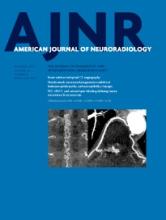Abstract
BACKGROUND AND PURPOSE: Epidermal growth factor receptor variant III is a common mutation in glioblastoma, found in approximately 25% of tumors. Epidermal growth factor receptor variant III may accelerate angiogenesis in malignant gliomas. We correlated T1-weighted dynamic contrast-enhanced MR imaging perfusion parameters with epidermal growth factor receptor variant III status.
MATERIALS AND METHODS: Eighty-two consecutive patients with glioblastoma and known epidermal growth factor receptor variant III status who had dynamic contrast-enhanced MR imaging before surgery were evaluated. Volumes of interest were drawn around the entire enhancing tumor on contrast T1-weighted images and then were transferred onto coregistered dynamic contrast-enhanced MR imaging perfusion maps. Histogram analysis with normalization was performed to determine the relative mean, 75th percentile, and 90th percentile values for plasma volume and contrast transfer coefficient. A Wilcoxon rank sum test was applied to assess the relationship between baseline perfusion parameters and positive epidermal growth factor receptor variant III status. The receiver operating characteristic method was used to select the cutoffs of the dynamic contrast-enhanced MR imaging perfusion parameters.
RESULTS: Increased relative plasma volume and increased relative contrast transfer coefficient parameters were both significantly associated with positive epidermal growth factor receptor variant III status. For epidermal growth factor receptor variant III–positive tumors, relative plasma volume mean was 9.3 and relative contrast transfer coefficient mean was 6.5; for epidermal growth factor receptor variant III–negative tumors, relative plasma volume mean was 3.6 and relative contrast transfer coefficient mean was 3.7 (relative plasma volume mean, P < .001, and relative contrast transfer coefficient mean, P = .008). The predictive powers of relative plasma volume histogram metrics outperformed those of the relative contrast transfer coefficient histogram metrics (P < = .004).
CONCLUSIONS: Dynamic contrast-enhanced MR imaging shows greater perfusion and leakiness in epidermal growth factor receptor variant III–positive glioblastomas than in epidermal growth factor receptor variant III–negative glioblastomas, consistent with the known effect of epidermal growth factor receptor variant III on angiogenesis. Quantitative evaluation of dynamic contrast-enhanced MR imaging may be useful as a noninvasive tool for correlating epidermal growth factor receptor variant III expression and related tumor neoangiogenesis. This potential may have implications for monitoring response to epidermal growth factor receptor variant III–targeted therapies.
ABBREVIATIONS:
- DCE
- dynamic contrast-enhanced
- EGFR
- epidermal growth factor receptor
- Ktrans
- contrast transfer coefficient
- rKtrans
- relative Ktrans
- ROC
- receiver operating characteristic
- rVP
- relative plasma volume
- 75%tile
- 75th percentile
- 90%tile
- 90th percentile
- VP
- plasma volume
- © 2015 by American Journal of Neuroradiology
Indicates open access to non-subscribers at www.ajnr.org












